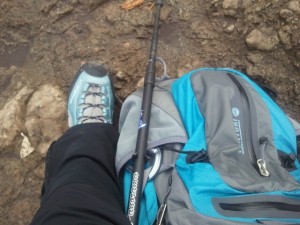Week 1: Climb for Clean Air – It’s a start
Week 1 Plan:
Mon: Rest
Tues: 30 mins cardio + strength training
Wed: Rest
Thu: 45 mins cardio
Fri: Strength training
Sat: Rest
Sun: 2 hours hike, 20lbs weight on the pack, low elevation gain
How it actually went down:
I suck. Let me just start by saying that. Yes, yes I know. My slate is clean and I’m not comparing myself with my old-self. Got it. It still really irritates the world out of me. I need to learn to be patient with myself and a be a little forgiving.
Tuesday:
I started with a 10 minutes warm up on the treadmill, no incline, and just run at 4.0 mph. Enough to get my juices flowing while I was listening Pump It from Black Eyed Pea. Then I did my strength training. I did dead lifts with 5lbs in each hand (which totally kicked my behind), Push Ups (a girly version of), Step ups and Lunges with 5lbs on each hand, Snow Shovelers with a 10lbs weight to simulate a shovel, Lateral Pull-downs with 40lbs, and Standing Calf Raises. I did 10 reps of each exercise, 2 sets total. My heart rate shot up to 172 (my max heart rate is 187, so that’s above my high zone) and I got a bit dizzy during dead lift. Yes. Out. Of. Shape. I have to keep reminding myself that this is my baseline and I need to pace myself.
I ended the training day by doing 30 minutes of cardio on an elliptical machine, cross ramp at level 10, 8 on the resistance scale. I had a hard time maintaining my heart rate within endurance zone (for me, it max out on 152) and I was going over all the time, but overall, I feel I did really well on the cardio.
Note: I went to climber meeting. It was nice to meet the other climbers and listen to Mark, our awesome trainer/guide for his tips/tricks. Laura, our event coordinator, wanted me to share my stories of why I climb to remind everybody on why are we doing this since we can easily loose focus with all the training and equipment. So I did. It was pretty good. Turns out, one of the gals in this years climb team was on the same 2005 climb team I was involved with before. In 2005 she had a different summit day and rope team, but we shared many memories. Small world.
Thursday:
Long Cardio day. I decided to take it up a notch. I put a couple 10lbs dumbbell’s inside my pack so I could add 20lbs to it and wore it through the workout. I started walkmeter and streamed Vertical Limit on my iPad2 (what better movie to motivate me than this one, right) out of Netfix. I started with a 10 minute warm up on a treadmill, set with 2% elevation grade for 2mph. Then I upped the grade to 12% for 45 minutes. Initially, I didn’t feel like I was doing anything – or at least my heart rate monitor seemed to fail to show me accurate results, so I bumped it up to a 15% grade and boy, was I wrong. Note to self – check heart rate monitor and make sure it was working before your work out! Goes to the point to check your gear before your climb. Above 12k feet on the side of a mountain is no place to discover that your gear is faulty. I was huffing and puffing on the 15% after only a few steps so I quickly brought it back down to 12% and stayed there. Overall, I did quite all right. After 5 minutes of cool down, my heart rate returned back to somewhat normal.
Friday:
Started out with a ten minute run on the treadmill as a warm up and boy, did I get warm! After the warm up I started the strength workout with a rear-foot-elevated squat hanging onto a 5lbs dumbbell in each hand. Thanks to u-tube and an iPad in the gym or else I would have no idea how to actually do this. I did okay on this, and was able to maintain my posture even though my heart rate quickly went to the roof. I could feel every muscle of mine scream in pain, but I know I did this one okay. Second one is a One-leg Deadlift and I have two-word for this. I suck. I can’t balance myself, let alone to go down with an extra 5lbs dumbbell in each hand. Quickly, I got frustrated and was a little discouraged when I wasn’t able to do a complete set without stumbling all over the place. Yes I know, patience… patience… patience. It just the beginning. Next one was One-arm Bent-over Rows. I did these with 10lbs dumbbells and did okay, followed by an overhead press with the same pair of 10lbs weights while sitting on a balancing ball instead of weight bench or standing up. Next one was a seated medicine-ball twist with a 4lbs medicine ball (yes, I know – baby medicine ball) and this one kicked my behind. It just seems so easy, but oh-my-golly, this work my cores like no tomorrow. Well, maybe like no rear-foot-elevated squat is supposed too. I ended up the set with dumbbell shrugs hanging onto a 20lbs dumbbell in each hand. I did 10 reps – 2 sets for each of the exercises and then went to work.
Sunday:
I decided to go to Little Si Mountain. With a 1,576 ft summit and a 1,100ft elevation gain, about 2.3miles one-way, I thought this would be a good Sunday afternoon hike. I packed 25lbs of weight in my backpack. It’s all water weight so I can rid them at the top to preserve my knee on the descent. It was raining and I was slightly cold so I put my fleece vest and wear my hard shell on top of my inside layer. I started music on my iPhone, started my Walkmeter and off I went. For those who never been to Little Si – the first 10 minutes is like a wake up call. It was steep, really steep and rocky trail. My heart got a good work out right off the bat but then the trail was really flat. I did really well and pace myself until about an hour when I thought we were in the last switchback. I noticed the trail became a really steep again and my heart rate went to the roof. I had to slow down and finally stopped for a minute to take a sip of water. I got really frustrated since I had a hard time getting my heart rate stabilized and had to walk really slow. All in all – I think I did okay. Note to self: Put gaiter on. The trail was wet and muddy and I had no gaiter on me. Good thing was the rain wasn’t really bad and I was able to keep my socks dry. Every hiker know that wet socks are hiker worst nightmare. I got up there in 1:15 mins. Not to shabby, I think. And no, I am not comparing this with my old-self. Let me say it again. Not too shabby for someone who just started training this week. At the top, it was cold and windy so we only stay for 10 minutes or so and head back down. We got down in 1:05mins with no weight on my backpack.
Fundraising Note:
I sent out my fundraising email out this week to all of my contacts. Big shout out to Brent Ozar (Blog | Twitter) for announcing it out on Twitter and Facebook for me AND generously donate to my cause as well to Robert Davis (Blog | Twitter) for including the link to my fundraising page on his slide deck during his presentation on SQL Saturday 68 at Olympia and asked everybody to support my cause. Because of you guys, I raise total $375.00 this week alone. From the bottom of my heart, thank YOU!
Update: Jen McCown started a ‘Get Hawt Friday’ (read her post here) and it’s a way to post your progress and make it accountable to public (just like what I did here). So here’s my contribution for Get Hawt Friday#001. It’s a summary from my week 1 (I publish mine every Sunday, so I will link that to your series on Friday). Love the idea!





